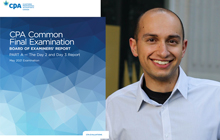Planning for PER (Part Two): How to write the CPA Canada practical experience requirements report

CPA program coach Gevorg Grigoryan, CPA provides PER tips and writing examples
 |
Gevorg Grigoryan, CPA, is an instructor, mentor and coach to students in the CPA program. |
VANCOUVER – In part one of this two-part series, Planning for PER: Writing the CPA practical experience requirements reports, I focused on the critical planning that is absolutely necessary to fulfil the practical experience requirements (PER) of the CPA program. Unfortunately, many candidates pass the Common Final Examination (CFE) and then must wait longer than is necessary to become a chartered professional accountant, simply because they did not plan ahead for the PER.
Once you’re ready to write your PER reports, however, here are four tips that I use when I’m coaching my students in the CPA program:
- Be mindful of the character limit in PERT. PERT has a limit of 5,000 characters (not words), which means you have to articulate your thoughts concisely but, at the same time, in enough detail so that the reviewers can understand your experience.
- Complete only eight technical and five enabling areas. If you work in a corporate role and you're under the experience verification route (EVR), you must complete both technical and enabling areas. Candidates make the mistake of reporting under all 20 technical sub-areas. This is not a good use of your time. PER requirements say that you only need to gain four Level 2 and four Level 1 rankings. You can gain this by targeting only eight areas.
- Make sure you understand the nuances of each area. For example, FR1, Financial Reporting Needs and Systems, requires you to discuss how you evaluated the financial reporting processes and systems to meet stakeholders needs. A mistake I see in candidate PER reports is that they forget to mention who are the stakeholders. Here are some examples of stakeholders you can use: the bank, lenders, government regulators, general public, customers, vendors, board of directors, investors, and shareholders.
- Mention professional values in enabling areas. For example, the enabling area EC1, Acting Ethically and Demonstrating Professional Values, requires that you write about a time when you faced an ethical dilemma and how you handled it. A common mistake I see in candidates is omitting the CPA values in the reports. Here are the CPA values you can write: competence, objectivity, due care, integrity, independence, professional behaviour and confidentiality.
In conclusion, I want to leave you with a few examples to guide you with the writing process. These are not complete reports, they are only the beginnings of full-length examples I use to coach my students in the CPA program, but they serve as good guidelines to help you understand the report structure.
PER example #1: FR1, Financial Reporting Needs and Systems
In my role as an Intermediate accountant, I recently worked with external consultants to implement new module in our ERP system. The stakeholders are the senior management, who are concerned with accurate financial reporting, and shareholders, who are concerned with return on their investments and understandability of the financial reports. Previously, my company was operating only in Canada and reported under CAD functional currency. With the expansion to the US, my company needed to change its financial reports to show USD amounts in order to meet the US shareholders’ needs. I participated in the design and implementation of the new module. I held meeting with the consultants and evaluated different options for generating foreign currency reports. As our company reports under IFRS, I researched IAS 21 standard in the CPA Canada Handbook to ensure the appropriate presentation rules are followed.
PER example #2: EC1, Acting Ethically and Demonstrating Professional Values
Recently, I was asked by a senior manager in my company to disclose confidential client information. As a junior staff accountant in the firm, I was not sure if this was the right thing to do. This dilemma impacted my professional values of integrity and confidentiality, because I wanted to act with integrity and safeguard client information. To approach this dilemma, I followed the CPA Way. I started with assessing the situation. My options are to disclose the sensitive information, thus breaking client confidentiality, ask my supervisor for advice, or confront the senior manager directly and explain why I’m not comfortable with their request.
Gevorg Grigoryan, CPA, is an instructor, mentor and coach to students in the CPA program. Visit Gevorg CPA to learn more and subscribe to Gevorg’s YouTube channel to access CPA program videos.
Top image: .JESHOOTS.COM on Unsplash. Author photo courtesy Gevorg Grigoryan, CPA.








(0) Comments